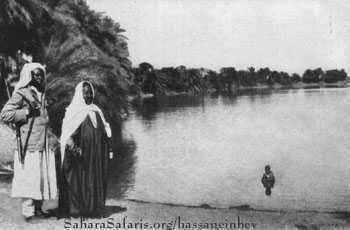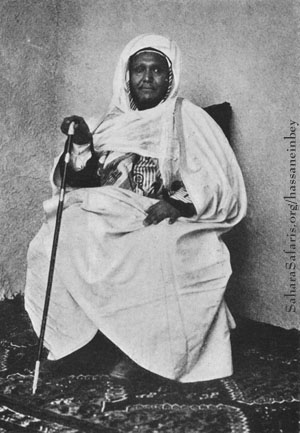LEADER AND MEN MUST FARE ALIKE
I have been asked why biscuits (crackers) were not
included as supplies for desert travel. The answer is that an entire
caravan devoted to their transport would hardly supply the voracity of
one Bedouin's appetite. I am confident that any of my entourage could
have consumed a cubic foot of biscuits in the course of a day's march.
The Bedouin can travel long and far on a limited amount of food, but
when plenty is at hand his powers of consumption are phenomenal. No
leader of a caravan need expect to carry dainties for himself and
maintain the morale of his men; for, once in the desert, master and man
are on the same plane, and each must share with the other all that he
has.
When an oasis is reached, a feast may be tendered
to the leader by the sheik, or head man, and less pretentious
entertainment provided for the men of the caravan. No resentment is felt
at such discrimination; but out in the sands each must subsist as every
other man in the caravan and do his share of the day's work, without
regard to rank.

THE
SALT-WATER LAKE OF KUFRA
This attractive body of water, with an
area of two square miles, is very deep in the center. The oasis
surrounds the lake. In the foreground is one of the notable Bedouin
chiefs of Kufra and one of the Senussi soldiers. When the author asked
this chief if there were fish in the lake, he replied: "What is a fish?
Does it walk? Does it fly?" It was found to be almost impossible to
describe a fish to a person who had never seen one. [photo page 246]
As a matter of fact, a greater tax was placed upon
my endurance than upon that of any other member of the organization;
for, in addition to the work of inspecting each camel load and taking a
hand at breaking and establishing camp, when all others were through for
the day or the night, as the case might be, it was
(p246)
then my responsibility to enter the scientific data in my diary, wind
and compare the six watches which I carried (four of which,
unfortunately, went out of commission before the end of the journey),
label and store the geological specimens collected, and record the films
used.
The theodolite was one of my chief cares on the journey, for the
Bedouins are extremely suspicious of this instrument. They had had
sufficient experience with European nations to deduce the fact that
where surveys of their country had been made armed forces generally
followed for purposes of conquest.
It therefore became necessary for me to practice pardonable deception in
order to utilize the instrument.

SAYED
MOHAMMED EL ABED, COUSIN OF THE HEAD OF THE SENUSSI SECT AND THE RULER
OF KUFRA
He proved very kind, helpful, and
hospitable to the expedition (see text, page 251). [photo page 247]
Readings were taken principal1y late in the
afternoon, and I always made my observations at some distance from
native settlements, explaining to the inquisitive Bedouins that the
theodolite was in reality a camera, which could be taken out of its box
in the twilight or dawn. I had to explain that the camera and the
theodolite worked alike, attracting pictures to them.
"How could a camera attract a picture far away from
it?" asked a Bedouin of the Nubian head man of my caravan, who was very
good at concocting harmless inaccuracies. Abdallah threw his hands in
the air: "Ask the magnet how he attracts the iron!" was the simple and,
to the Bedouin, convincing reply.
 
|
